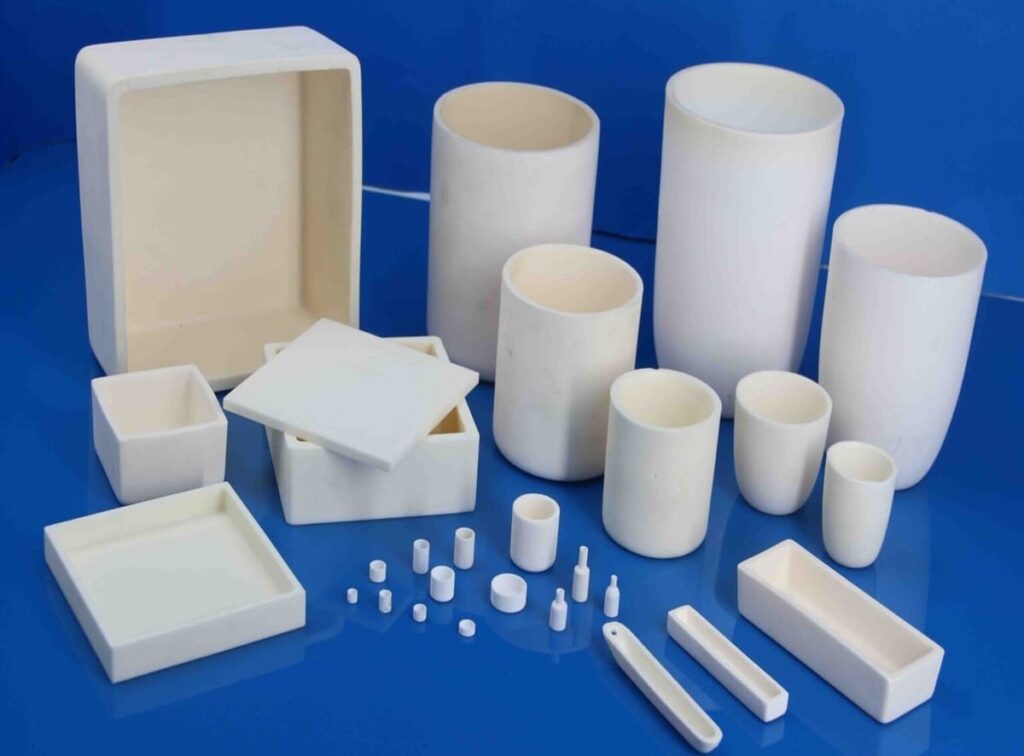Alumina Ceramics: Properties for Engineering Applications
Introduction
Alumina ceramics (Al₂O₃), or aluminum oxide, are advanced non-metallic materials known for their mechanical strength, thermal stability, and electrical insulation. Available in purities of 95%, 97.5%, 99%, and 99.5% Al₂O₃, these ceramics are ideal for engineering applications in electronics, mechanical systems, and thermal management. This article details the key properties of alumina ceramics, supported by a comparative table, to highlight their suitability for engineering solutions.
Properties of Alumina Ceramics
Alumina ceramics offer a range of mechanical, thermal, electrical, and chemical properties, making them suitable for demanding engineering applications. Below are their primary characteristics:
- High Hardness: Vickers hardness ranges from 13.7 GPa (95% Al₂O₃) to 17.5 GPa (99.5% Al₂O₃), ideal for wear-resistant components.
- Mechanical Strength: Flexural strength from 310 MPa (97.5% Al₂O₃) to 400 MPa (99.5% Al₂O₃), suitable for load-bearing applications.
- Thermal Conductivity: Ranges from 24 W/(m·K) (95% Al₂O₃) to 34 W/(m·K) (99.5% Al₂O₃), supporting heat dissipation.
- Electrical Insulation: Volume resistivity >10¹⁴ ohm-cm across all grades, ensuring reliability in electronic systems.
- Corrosion Resistance: Minimal weight loss in acids (e.g., 0.03 mg/cm²/day in HNO₃ for 99.5% Al₂O₃), perfect for harsh environments.
Detailed Properties Table
The table below compares the properties of alumina ceramics across 95%, 97.5%, 99%, and 99.5% Al₂O₃ grades.
| Property | 95% Al₂O₃ | 97.5% Al₂O₃ | 99% Al₂O₃ | 99.5% Al₂O₃ |
| Main Characteristics | ||||
| Color | White | White | White | White |
| Main Applications | Metallization, wear resistance | High wear resistance | High temperature, wear resistance | High temperature, wear resistance |
| Characteristics | High strength, wear resistance, corrosion resistance, insulation | High strength, corrosion resistance | High strength, corrosion resistance | High strength, corrosion resistance |
| Mechanical Properties | ||||
| Bulk Density (g/cm³) | 3.7 | 3.8 | 3.9 | 3.9 |
| Water Absorption (%) | 0 | 0 | 0 | 0 |
| Vickers Hardness (GPa) | 13.7 | 15.2 | 17.2 | 17.5 |
| Flexural Strength (MPa) | 350 | 310 | 380 | 400 |
| Compressive Strength (MPa) | — | — | — | 3800 |
| Young’s Modulus (GPa) | 320 | 360 | 380 | 380 |
| Poisson’s Ratio | 0.23 | 0.23 | 0.23 | 0.23 |
| Fracture Toughness (MPa m¹/²) | 3–4 | 5–6 | — | — |
| Thermal Properties | ||||
| Specific Heat Capacity (J/(kg·K) × 10⁻³, 400°C) | 7.2 | 7.2 | 7.2 | 7.2 |
| Thermal Conductivity (W/(m·K)) | 24 | 25 | 32 | 34 |
| Thermal Shock Resistance (ΔT°C) | 200 | 200 | 200 | 200 |
| Electrical Properties | ||||
| Volume Resistivity (ohm-cm) | >10¹⁴ | >10¹⁴ | >10¹⁴ | >10¹⁴ |
| Dielectric Strength (kV/mm) | 15 | 15 | 15 | 15 |
| Dielectric Constant (1 MHz) | 9.4 | 9.9 | 9.9 | 9.9 |
| Dielectric Loss (×10⁻⁴) | 38 | 20 | 10 | 10 |
| Chemical Properties | ||||
| Nitric Acid (60%) Weight Loss (mg/cm²/day) | 0.10 | 0.05 | 0.03 | 0.03 |
| Sulfuric Acid (95%) Weight Loss (mg/cm²/day) | 0.33 | 0.22 | 0.19 | 0.19 |
| Caustic Soda (30%) Weight Loss (mg/cm²/day) | 0.06 | 0.04 | 0.03 | 0.03 |
Table Notes:
- Mechanical Properties: Higher-purity grades (99% and 99.5% Al₂O₃) offer increased hardness (17.2–17.5 GPa) and flexural strength (380–400 MPa).
- Thermal Properties: Thermal conductivity improves with purity, from 24 W/(m·K) to 34 W/(m·K).
- Chemical Resistance: Higher purity reduces weight loss in acids, enhancing corrosion resistance.
Conclusion
Alumina ceramics offer exceptional mechanical strength, thermal stability, and electrical insulation, making them ideal for engineering applications in electronics, mechanical systems, and thermal management. The range of purities allows for tailored solutions in demanding environments.
Advanced Ceramics Hub is a leading manufacturer and supplier of high-quality alumina ceramic products in forms of plates, sheets, rods, tubes, crucibles, substrates, and customized parts, offering customized solutions for various industrial and research applications.

